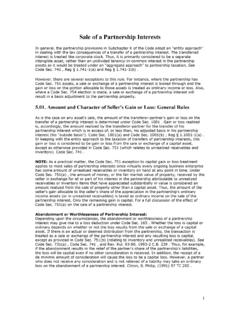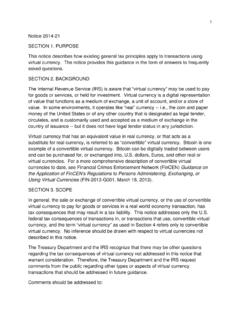Transcription of ALLOCATION OF INCOME AND LOSS - taxtaxtax.com
1 ALLOCATION OF INCOMEAND LOSS900 A partnership is not subject to tax at the partnership level. The partnership s items of INCOME , gain, loss , deduction, and credit are determined at the partnership level, allocated among the partnersaccording to the partnership agreement, and reported to the partners on Schedule K-1 of the partnershipincome tax return (Form 1065). The partners then report these items on their own tax returns. In practice,the allocated amounts are commonly referred to as K-1 items. Technically, they are distributive shares ofpartnership In understanding the rules governing distributive shares [under IRC Sec. 704(b)], it is important torecognize that in every partnership transaction, there are (at least) two separate ALLOCATION systemsinvolved: 1. allocations of economic results per the partners economic agreement, and 2. allocations of tax items under applicable tax rules (both federal and state, which themselves maybe different).
2 To make matters more complicated, additional accounting systems are frequently involved inreporting partnership INCOME or loss , such as GAAP, regulatory agency accounting, and special financialaccounting. This often creates confusion when discussing partnership allocations. This chapterdiscusses economic and tax The economic and tax treatments of any partnership transaction are related, but they are notnecessarily the same. The tax ALLOCATION rules of IRC Sec. 704 are designed to ensure that the allocationof tax results to the partners follows the ALLOCATION of economic results. In this chapter, and in analyzingany ALLOCATION , it is extremely important to understand whether a particular ALLOCATION is the economictreatment of the applicable item or the corresponding tax treatment of the item, and to focus on how thetwo types of allocations are related and how they are different.
3 (See the practice tips beginning atparagraph for a discussion of tax versus economics.) The ALLOCATION of INCOME and loss is generally made according to the terms of the partnershipagreement. However, if the allocations described in the partnership agreement do not have substantialeconomic effect, or are not in accordance with the partners interests in the partnership, the accountantmust allocate partnership taxable INCOME or loss in a manner different than that provided in thepartnership TESTING PARTNERSHIP ALLOCATIONSTwo Ways to Test There are two avenues for testing the viability of a tax ALLOCATION under IRC Sec. 704 and itsapplicable regulations: 1. by showing that the ALLOCATION is in accordance with the partner s interest in (see the discussion at section 903), or 2. by showing that the ALLOCATION has substantial economic effect under the safe harborprovisions (see the discussion at section 904).
4 Partnerships historically have been granted considerable latitude in allocating INCOME , gain, losses,deductions, and credits among their partners for tax purposes. In recent years, however, Congress, thecourts, and the IRS have clarified and increased restrictions on partnership tax allocations. The generalrule is that tax allocations must be in accordance with the partners interests in the partnership basedon the partners economic agreement taking into account all facts and circumstances. Generally,partners cannot allocate tax items in a manner inconsistent with allocations of the correspondingeconomic items. This ensures that if a partner reaps the economic benefit of an INCOME or gain ALLOCATION ,that same partner is allocated the INCOME or gain for tax purposes. By the same token, if a partner bearsthe economic cost of an ALLOCATION of loss , that same partner should be allocated the loss for The regulations provide a safe harbor the substantial economic effect rules with which apartnership can comply to avoid the uncertainties of the general and more nebulous partners interests inthe partnership rules.
5 These safe harbor rules contain the detailed capital account bookkeeping rules thathave received so much attention in tax accounting literature. The safe harbor capital account maintenancerules are really nothing more than an attempt to establish uniform bookkeeping procedures for theeconomic (not tax) results of partnership operations. Once the economic bookkeeping has been properlydone, the ALLOCATION of tax results among the partners must be made in a manner consistent with theallocation of the corresponding economic : Assume two equal partners own their partnership interests all year and have identical capitalaccounts. If the partnership agreement allocates the overall economic gain and loss between the twopartners 50/50, it cannot allocate the tax results 75/25. Likewise, if the partners agree to specially allocateone item for economic purposes, they must allocate the associated tax results for that item on the samebasis (subject to certain special rules see discussion beginning at paragraph ).
6 For example, if theeconomic gain from the sale of a building is specially allocated 75% to one partner and 25% to another,the tax gain on the sale must also be allocated 75/25. In the presence of such a special economicallocation, the partners could not allocate the tax gain from sale of the building on a 50/50 basis eventhough 50/50 is their basic, overall agreement. Certain tax allocations do not have a corresponding economic element (in other words, theallocations do not affect the dollar value of a partner s interest). Examples include allocations of taxcredits, percentage depletion in excess of cost, and deductions related to nonrecourse of these items are made according to the partners interests in the partnership under specialrules set forth in the regulations. (See section 913 for a discussion of credits and section 911 andCase Studies 9M, 9N, and 9O for discussions of deductions related to nonrecourse liabilities.)
7 IRC Sec. 704 is not the exclusive test for determining the validity and tax consequences of a taxallocation. Other tax principles must also be considered, such as whether the ALLOCATION involvesassignment of INCOME , misallocation of INCOME among related parties, family partnerships, employeecompensation, a gift, a sale, or other special situations. In other words, while an ALLOCATION may satisfythe Section 704(b) rules, other Code sections may still affect the tax treatment of that versus The biggest source of confusion in the ALLOCATION area is the failure to recognize that eachtransaction has separate economic and tax components. This confusion is frequently caused by the factthat in many transactions the economic and tax results are identical in all respects, making it hard todistinguish between the two. For example, if a partnership spends $10 in cash for a deductible item, theeconomic result is a $10 loss and the parallel tax result is also a $10 loss .
8 The partner allocated the $10economic loss must also be allocated the $10 tax loss . The fact that the economic and tax treatments areidentical causes their separateness to be overlooked. This oversight often results in the ALLOCATION of taxresults (usually tax losses) without consideration of the underlying economic ALLOCATION . In analyzing a partnership agreement for the underlying economic arrangement of the partners, thepractitioner must consider the agreement as a whole, not just the profit and loss allocations. Almostinvariably, agreements that have suspect tax allocations attempt to treat an item of INCOME or loss in onesection of the document in a manner that is inconsistent with the treatment of that same item elsewhere inthe agreement. For example, in a suspect partnership agreement, a loss allocated under the profit andloss provisions of the agreement may not have any effect on the liquidating distributions (typically coveredin another section of the agreement) that the partners receive upon a partnership termination.
9 Anagreement may, for tax purposes, allocate losses to one partner, while providing that distributions(including liquidating distributions) are to be shared equally. This is a classic example of an ALLOCATION thatdoes not have economic effect. In such situations, a question may arise over which section of thepartnership agreement controls. If a partner is allocated a tax loss , but the ALLOCATION does not affect hisdistribution rights, which controls the tax loss ALLOCATION provision or the distribution provision?Generally, the contribution and distribution provisions of an agreement are deemed to control the profitand loss ALLOCATION provisions. So, in the above case, the tax loss ALLOCATION should be coordinated withthe distribution provision, and not the other way around. This determination of which section of thepartnership agreement controls, however, is a matter of local law and the partners are cautioned against adopting interpretations of the agreement for tax purposes that maybe inconsistent with the real economic agreement of the partners.
10 902 EFFECT OF PARTNERSHIP AGREEMENTA llocation of Tax Generally, partnerships have a written partnership agreement that sets out the partners duties andthe ALLOCATION to those partners of the partnership s tax and economic items. IRC Sec. 704(a) provides thatthis agreement governs the ALLOCATION of taxable INCOME , gain, loss , deduction, and credit among thepartners. By appearing to imply that partners have the ability to allocate tax results, IRC Sec. 704(a)creates a trap for the uninitiated because it seems to give the partners greater power to govern theallocation of partnership tax items than they actually have. In reality, tax allocations cannot be madeindependently of the corresponding economic results, and in fact merely follow the related economicallocations made under the partnership agreement. In the event that the partnershipagreement s tax allocations do not have substantial economic effect or if the agreement is silentconcerning tax allocations then the tax allocations must be in accordance with the partners interests inthe of Economic IRC Sec.









